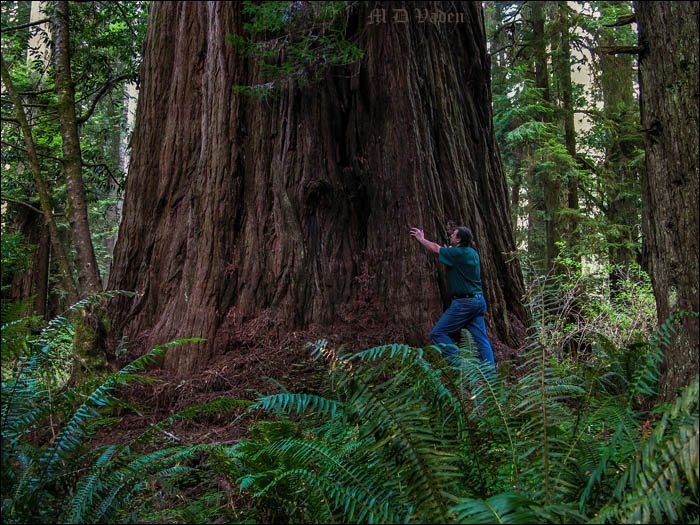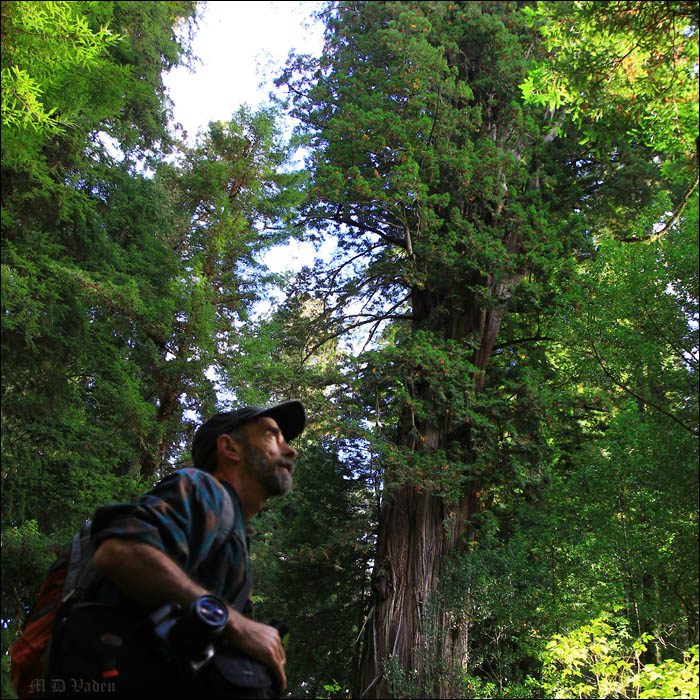
Iluvatar coast redwood - 3rd largest
Was #1 until 2014
by Mario Vaden
The coast redwood Iluvatar is located in Prairie Creek Redwoods State park. The Iluvatar was the largest known coast redwood for quite a few years until 2014 when new discoveries were made. In 2014 it became more like 3rd largest, but even more redwoods were found from 2015 forward. During previous years, quite a few people including author Preston rated Lost Monarch bigger by adding 6,000 cubic feet of a separated extra stem to its total volume. But Lost Monarch is two trees close together. I added a new photo to the Lost Monarch page showing the gap separating trunks. Whereas Iluvatar is actually larger, better photo opportunities may be available north at the Grove of Titans

advertisement
Iluvatar is also home to other plants that grow on it, including Cascara Buckthorn, Huckleberry and ferns. It's old enough to become a garden above the forest floor. For reference 2009 data noted Iluvatar as 3rd largest among coast redwoods. 300.2 feet or 91.5 meters tall, 20.5 feet diameter dbh and 37,500 cubic feet wood volume with main stem and other combined.
Iluvatar has a very large canopy with almost 220 trunks and stems filling 30,000 cubic yards of space overhead. Robert Van Pelt wrote in Forest Giants of the Pacific Coast that the canopy was the largest, occupying over 50,000 cubic yards. Either Robert Van Pelt or Richard Preston also wrote about the natural fusion grafts of branches, comparing this redwood to the triangular beams of the Eiffel Tower for strength.
In the first image, I am next to the trunk for scale. In the second image, the canopy lurks behind Andrew Joslin, who illustrated this redwood in a book The Wild Trees. Andrew is gazing at Iluvatar and Atlas Grove. It is one of many redwoods in what was called the Atlas Grove study project on an alluvial terrace of Prairie Creek. A old study report noted the flat is where sedimentation happened centuries ago.
... continue below photos

Other redwoods of the study plot were given names like Kronos, Rhea, Zeus, Pleiades I, Pleiades II, , Bell, Ballantine, Broken Top, Prometheus, Epimetheus, Buena Vista, Demeter. The size of Atlas Grove is undisclosed, but it is much bigger than a couple of acres. The plot was a 1 hectare which is 2.47 acres.
Author Richard Preston wrote many things about Iluvatar in his best selling book released 2007. In case you are interested I will repeat this link to my redwood book review

Some folks speculated whether Iluvatar is the huge redwood in the composite photo that National Geographic put in their October 2009 issue. Maybe you will order a copy. But Iluvatar is the t coast redwood in that magazine. The National Geographic photographer for that issue was Michael Nichols. He made a final composite image using 84 photographs. Those were taken by raising cameras up the canopy.
And how do researchers enter the canopy? They used a bow to send rubber tipped arrows over sturdy limb. The arrow pulls a small line, which is used to pull a bit larger line, and that next one to pull the climbing line. Dr. Robert Van Pelt wrote that Illuvatar's trunk has almost a triangular footprint where it meets the forest floor. That makes measuring different, even more challenging that round or elliptical trunks. And what is up there besides redwood foliage? Here is an excerpt from a Humboldt State Univerisity study:
"Five species of vascular epiphytes grow on Iluvatar ...... The evergreen fern Polypodium scouleri is the most numerous species with 36 mats growing on branches or in crotches. Using equations developed by Bailey (2000), we estimated the P. scouleri biomass on Iluvatar to be 18.2 kg with an additional 47.2 kg of associated humus. The second most abundant species is the ericaceious shrub, Vaccinium ovatum. Eight of the shrubs grow from rotting wood or humus on the main trunk above 60 m. Two of the shrubs grow on branches of reiterated trunks. The deciduous fern, Polypodium glycyrrhiza, grows intermixed with P. scouleri on a 15 cm diameter branch. The deciduous tree, Rhamnus purshiana, grows with P. scouleri on a large humus accumulation at the base of trunk II. Finally, the evergreen tree, Umbellularia californica, grows near P. scouleri on a humus-covered burl"
Iluvatar was also one of several redwoods climbed to study the Wandering Salamander, Aneides vagrans. That species was found on Iluvatar and several other redwoods in Atlas Grove. Giant Salamanders also live in the area but reside mainly near the forest floor. As for the canopy above, the crown is complex and said to have the only "class 6" reiteration found in a redwood, decribed as:
"Trunk 1 is the largest known reiterated trunk on a redwood and the most complex region of Iluvatar's crown. It includes the only class 6 reiteration (i.e., a trunk from a trunk from a trunk from a trunk from a trunk from a trunk) known on a redwood"
This is part of the conclusion from the study report I found interesting:
"Iluvatar may represent an extreme in the realm of forest ecology. Having developed on rich soils with abundant resources over more than a millennium, its massive reiterated complexes have become fused, and structural failure of the crown now seems nearly impossible"
I'm curious to see where future research leads with coast redwoods and reiterations, because we discovered something early 2014 with such a massive crown, it may have similar or greater complexity. Viewing from a distance, the crown seems bigger than Illuvatar. Its a discovery I did not disclose or describe on my "year of discovery" page which was added and updated 2014 and following.